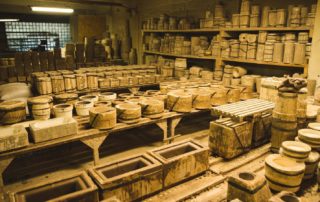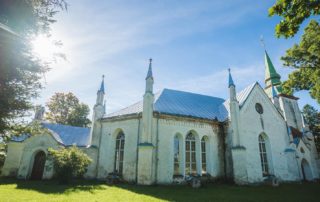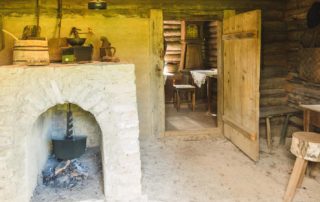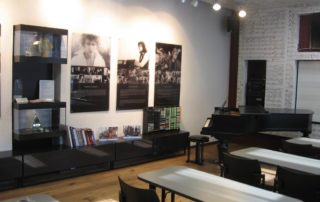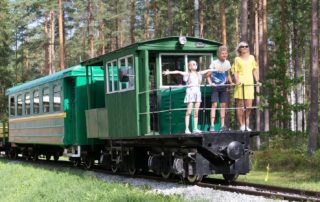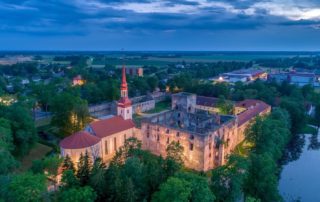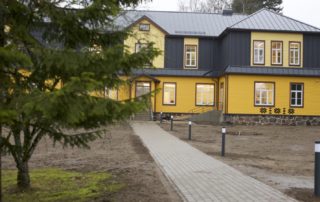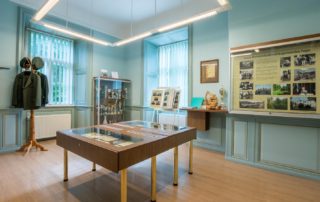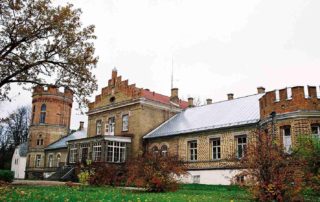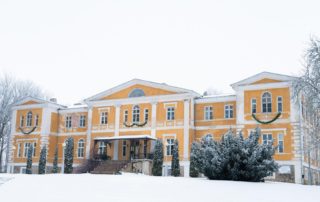Siimusti Clay Industry
Siimusti Ceramics operates from the clay factory, which was founded in 1886 by Joosep Tiimann, a man born from a family of farmers. The location was suitable due to the clay deposits present here. At first the brick manufactury was created; afterwards they started producing oven pots and dishware. Nowadays you can get acquainted with the manufacturing process of ceramics: The pouring of clay into the mold and the firing and glazing processes. The end product can be bought onsite.
Kursi’s Sts. Mary and Elisabeth Church of the Estonian Evangelical Lutheran Church
Baroque architecture in concordance with pseudo Gothic architecture (alteration by Johann Gottfired Mühlhausen). Twelve small spiring pinnacles symbolise the twelve apostles of Jesus. The church manor is a historical parochial centre; there is a museum in the vicarage (built in 1817).
Paduvere Farm Museum
The museum introduces the life led by farmers in the 18th century and the everyday lives and work of our forefathers. There are five oak sculptures created by St Petersburg artist Grigori Azarenkov by the museum. The museum is surrounded by beautiful landscapes, which make it a popular venue for folk parties and theatre performances.
Alo Mattiisen’s piano classroom
In the centre of the town, at Jõgeva Music School, where Alo Mattiisen studied, a memorial was unveiled to mark his 45th birthday. Five years later, in 2011, his piano classroom was also completed to celebrate his 50th birthday. It features his fully restored piano and a display of the composer's personal items. The classroom can be used to host small concerts, training sessions, conferences and music lessons.
Avinurme museum train
A narrow-gauge Sonda-Mustvee railway passed through Avinurme during 1926–1972. It was a true 50-year-long prosperity era for the villages located near the route. Today, a section of 178.5 metres of the former railway, the rail brigde, and the rail vehicle have been restored. All those who are interested are welcomed to take a nostalgic train ride from May to October, meaning the railway is opened when the weather is warm enough and the door of the locomotive can be opened and the railway is closed when the door of the locomotive freezes shut.
Põltsamaa Castle
The stone fortress was constructed on the banks of the Põltsamaa River already in 1272. Later on (1570–1578) the fortress was the residence of Livonia's King Magnus. Repeatedly pillaged, the castle was rebuilt by Woldemar Johann von Lauw. In the 18th century the fortress became a grand rococo-style palace. The castle and the church burnt down in 1941. Only the church was restored in 1952. The castle remained in ruins, waiting for its time. The complex is open again from the summer of 2023. The castle tower, convent building, and gate building are open to visitors, where you can find [...]
Kalevipoeg’s Museum
The Kalevipoeg Museum represents one of the 21 places, marked with a National Geographic's yellow window, that are worth exploring in Southern Estonia. The museum is named after Estonian national epic "Kalevipoeg" because the Kääpa River is where the sword of Kalevipoeg is located, and around it are resting places, rocks, springs, swamps, and furrows. In Kalevipoeg Museum, you get a good overview of the Estonian national epic. If you want, you can listen to the whole epic or sit abroad a huge ship called the Plane and watch a short film, where drone shots of beautiful Estonian places alternate with [...]
Luua Manor museum rooms
The beautiful Luua Manor is home to the museum rooms of Luua Forestry School, which showcase the history of both the school and the manor. A number of the rooms in the manor have been restored to their original state and opened up to visitors. Here you can admire the timeless beauty of the manor, find out about the history of its park and the surrounding area and take a look at awards and old school documents. There is also a large collection of stuffed birds and animals from the surrounding forests. Did you know...? *Every summer the manor takes [...]
Lustivere Manor
First records which mention the manor date back to 1552. The manor house inspired by Neo-Gothic style was built based on the designs of an architect and researcher of antiquities from Tartu, R.von Guleke, and it is one of the most remarkable manor houses in the centre of Estonia. At present the manor houses a retirement home. * The manor can only be viewed from the outside.
Kuremaa Castle and Park
Kuremaa Classicist manor house was built in 1837-1843 by the von Oettingen family. The manor house was designed by the architect E. J. T. Strauss from Tartu. There is also a room for a museum in the castle which gives an overview of the region and of the history of Kuremaa Agricultural School. At present the rooms of the castle are used for organising conferences. The park rich in species descends towards lake Kuremaa which attracts visitors with its well-kept beach and possibilities for taking a rest.

